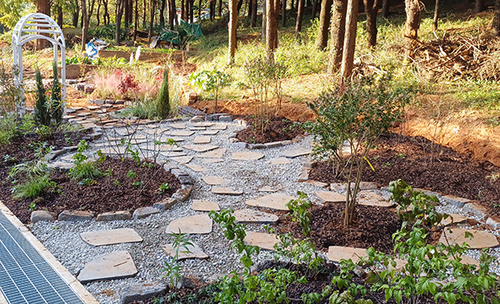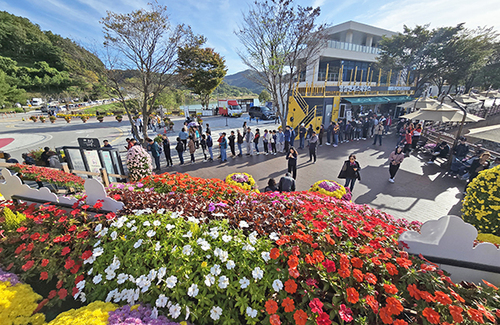| в–І нҷ©мқёнҷҚ(мҷјмӘҪм—җм„ң л‘җ лІҲм§ё) м „л¶Ғ л¬ҙмЈјкө°мҲҳк°Җ м§ҖлӮң 5мқј 'л‘җкёёкөҗнҡҢгҶҚм„ӨнҳёмӮ¬(йӣӘж№–зҘ )гҶҚк№Җн•ҙк№Җм”Ё(йҮ‘жө·йҮ‘ж°Ҹ) к№ҖлІ”мҲҳ мҶҢмһҘ кі л¬ём„ң' мҶҢмң мһҗ л°Ҹ кҙҖлҰ¬лӢЁмІҙм—җ к°Ғк°Ғ 'н–ҘнҶ л¬ёнҷ”мң мӮ° м§Җм •м„ң'лҘј м „лӢ¬н•ң л’Ө кё°л…җмҙ¬мҳҒмқ„ н•ҳкі мһҲлӢӨ. / мӮ¬м§„м ңкіө = л¬ҙмЈјкө°мІӯ © к№Җнҳ„мў… кё°мһҗ |
|
л‘җкёёкөҗнҡҢгҶҚм„ӨнҳёмӮ¬(йӣӘж№–зҘ )гҶҚк№Җн•ҙк№Җм”Ё(йҮ‘жө·йҮ‘ж°Ҹ) к№ҖлІ”мҲҳ мҶҢмһҘ кі л¬ём„ңмқё көҗм§Җ л“ұ 39м җмқҙ л¬ҙмЈјкө° н–ҘнҶ л¬ёнҷ”мң мӮ°мңјлЎң м§Җм •лҗҗлӢӨ.
м „л¶Ғ л¬ҙмЈјкө°мқҖ "н–ҘнҶ л¬ёнҷ”мң мӮ°мқ„ м Ғк·№ л°ңкөҙн•ҳкі м§Җм •н•ҙ к·ё к°Җм№ҳлҘј нӣ„лҢҖм—җ м „н•ҳкі ліҙмЎҙгҶҚкҙҖлҰ¬м—җ л§Ңм „мқ„ кё°н•ҳкё° мң„н•ҙ мқҙлІҲм—җ мӢ к·ңлЎң м§Җм •н•ң 3кұҙ мҷём—җлҸ„ кёҲк°җ лІјлЈ»кёёгҶҚмңЎмҳҒмһ¬гҶҚмқҳлі‘мһҘ мһҘм§Җнҳ„ мһҘкө° л¬ҳм—ӯ л“ұ 15кұҙмқ„ ліҙмң н•ҳкІҢ лҗҗлӢӨ"кі 7мқј л°қнҳ”лӢӨ.
'н–ҘнҶ л¬ёнҷ”мң мӮ°'мқҖ л¬ёнҷ”мһ¬ліҙнҳёлІ• лҳҗлҠ” мӢңгҶҚлҸ„ л¬ёнҷ”мһ¬лЎң м§Җм •лҗҳм§Җ м•ҠмқҖ л¬ёнҷ”мһ¬ к°ҖмҡҙлҚ° н–ҘнҶ л¬ёнҷ”ліҙмЎҙмғҒ н•„мҡ”н•ҳлӢӨкі мқём •н•ҙ мӢң(кө°)гҶҚлҸ„ мЎ°лЎҖм—җ кё°л°ҳмқ„ л‘җкі м§ҖмһҗмІҙмһҘмқҙ м§Җм •н•ҳлҠ” л¬ёнҷ”мһ¬лӢӨ.
мқҙлІҲм—җ мӢ к·ң м§Җм •лҗң 'л‘җкёёкөҗнҡҢ(м„ӨмІңл©ҙ)'лҠ” кө¬н•ңл§җ л§ҲлЎңлҚ• м„ көҗмӮ¬к°Җ л¬ҙмЈј мҲңлЎҖлҘј нҶөн•ҙ м„ӨлҰҪ(1904л…„)н•ң көҗнҡҢлӢӨ.
нҠ№нһҲ 1954л…„ көҗмқёл“Өмқҙ кұҙ축н•ң л‘җкёёкөҗнҡҢ кө¬ мҳҲл°°лӢ№мқҖ л¬ҙмЈјгҶҚ진м•ҲгҶҚмһҘмҲҳ л“ұ лҸҷл¶Җк¶Ң м§Җм—ӯм—җ лӮЁм•„мһҲлҠ” к·јлҢҖкөҗнҡҢ кұҙ축물 мӨ‘ к°ҖмһҘ мҳӨлһҳлҗң кІғмңјлЎң кё°лҸ…көҗк°Җ мң мһ…лҗң кіјм •мқ„ мӮҙн•„ мҲҳ мһҲлҠ” кұҙ축н•ҷм ҒгҶҚм—ӯмӮ¬м Ғ к°Җм№ҳк°Җ лҶ’кІҢ нҸүк°ҖлҗҗлӢӨ.
лҳҗн•ң кё°лҸ…көҗ мң мһ…кіјм •м—җ лӮҳнғҖлӮҳлҠ” м„ңм–‘ кұҙ축양мӢқкіј н•ңмӢқ лӘ©кө¬мЎ°к°Җ кІ°н•©лҗң м–‘мӢқмқҙ м—ҝліҙмқҙкі лӮЁгҶҚм—¬ м¶ңмһ…мӢңм„Өмқҙ кө¬лі„лҸј мһҲлҠ” кІғмқҙ нҠ№м§•мқҙлӢӨ.
'м„ӨнҳёмӮ¬'лҠ” м„ӨмІңл©ҙ м¶ңмӢ мңјлЎң мЎ°м„ нӣ„кё° л¬ёмӢ мқҙмһҗ н•ҷмһҗмқё л°•м№ҳмӣҗмқҳ мӢңгҶҚл…јліҖгҶҚм°¬гҶҚм ңл¬ё л“ұмқ„ мҲҳлЎқн•ң мӢң문집мқё м„Өкі„мҲҳлЎқ 집필мһҗмқҳ н•ҷл¬ёкіј лҚ•н–үмқ„ 추лӘЁн•ҳкё° мң„н•ҙ мІ мў… 11л…„(1860)м—җ кұҙлҰҪлҗң мӮ¬мҡ°(лӘ©мЎ°кұҙ축)лЎң мқёл¬јм—җ лҢҖн•ң к°Җм№ҳлҘј мқём •л°ӣм•ҳлӢӨ.
л°•м№ҳмӣҗмқҖ м–ҙл Өм„ң мҶЎлӘ…нқ мқҳ л¬ён•ҳм—җм„ң мҲҳн•ҷн–Ҳмңјл©° 18м„ё л•Ң м•„лІ„м§Җк°Җ лҸҢм•„к°ҖмӢ нӣ„ мҳӨлһ«лҸҷм•Ҳ нҶ мӢӨм—җм„ң кё°кұ°н•ҳл©ҙм„ң мң к°Җмқҳ кІҪм „кіј м„ұлҰ¬м„ңлҘј лӘЁл‘җ м„ӯл өн•ҳкі лҸ„к°ҖгҶҚл¶Ҳк°ҖгҶҚкё°л°ұмқҳ мқҳмҲ к№Ңм§Җ л‘җлЈЁ м—°н•ҷн•ң мқҖмӮ¬(йҡұеЈ« = лІјмҠ¬мқ„ н•ҳм§Җ м•Ҡкі мҲЁм–ҙ н•ҷл¬ён•ң м„ л№„)лЎң кјҪнһҢлӢӨ.
к·ёмқҳ м Җм„ң 'м„Өкі„мҲҳлЎқ'мқҖ мң нҳ•мӣҗмқҳ 'л°ҳкі„мҲҳлЎқ'мқҙлӮҳ мқҙмқөмқҳ 'м„ұнҳём„ңм„Ө'кіј м„ңлЎң н‘ңлҰ¬лҘј мқҙлЈ¬лӢӨлҠ” нҸүк°ҖлҘј л°ӣкі мһҲлӢӨ.
'к№Җн•ҙк№Җм”Ё к№ҖлІ”мҲҳ мҶҢмһҘ кі л¬ём„ң'лҠ” м•ҲкІҪкіөнҢҢ 23м„ёмҶҗмқё к№ҖлІ”мҲҳм”Ё(м ҒмғҒл©ҙ м¶ңмӢ )к°Җ мҶҢмһҘн•ҳкі мһҲлҠ” кі л¬ём„ңлЎң көҗм§ҖгҶҚмІ©гҶҚм „л №гҶҚнҳём ҒлҘҳ л“ұ мҙқ 39м җмқҙлӢӨ.
6лҢҖмЎ° к№Җ진м„ұмқҳ 'м ҒмғҒмӮ°м„ұ лі„мһҘ м°Ём •мІ©'мқҖ л¬ҙмЈј м ҒмғҒмӮ° мӮ¬кі мҷҖ кҙҖл Ёлҗң мһҗлЈҢлЎң к°Җм№ҳк°Җ лҶ’лӢӨкі нҸүк°Җ лҗҗмңјл©° 'мӨҖнҳёкө¬' л°Ҹ 'нҳёкө¬лӢЁмһҗ' л“ұ кҙҖл¬ём„ң лҳҗн•ң л¬ҙмЈјл¶Җ(иҢӮжңұеәң)м—җм„ң л°ңкёүн•ң кІғл“ӨлЎң лӢ№мӢң18~19м„ёкё° м§Җм—ӯ мқёл¬јл“Өмқҳ лӢӨм–‘н•ң нҷңлҸҷ мӮ¬н•ӯкіј л¬ёнҷ”мӮ¬гҶҚмғқнҷңмӮ¬лҘј м•Ңм•„ліј мҲҳ мһҲлҠ” м—°кө¬ мӮ¬лЈҢм Ғ к°Җм№ҳлҘј мқём •л°ӣм•„ м§Җм •лҗҗлӢӨ.
нҷ©мқёнҷҚ л¬ҙмЈјкө°мҲҳлҠ” "ліҙмЎҙк°Җм№ҳк°Җ мһҲлҠ” мқём ҒгҶҚл¬јм Ғ н–ҘнҶ л¬ёнҷ”мң мӮ°мқ„ л°ңкөҙн–ҲлӢӨлҠ” кІғм—җ мһҗл¶ҖмӢ¬мқ„ лҠҗлӮҖлӢӨ"л©° "л¬ёнҷ”мң мӮ°мқҳ к°Җм№ҳлҘј кҙҖкҙ‘мһҗмӣҗнҷ” мӢңнӮӨлҠ” л“ұ м§Җм—ӯ мһҗмӮ°мңјлЎң нҷңмҡ©н• мҲҳ мһҲлҠ” л°©м•Ҳл“Өмқ„ лӘЁмғүн•ҙ лӮҳк°Ҳ кі„нҡҚ"мқҙлқјкі л§җн–ҲлӢӨ.
вҳһ м•„лһҳлҠ” мң„ кё°мӮ¬лҘј кө¬кёҖ лІҲм—ӯмқҙ лІҲм—ӯн•ң мҳҒл¬ё кё°мӮ¬мқҳ 'м „л¬ё' мһ…лӢҲлӢӨ.
кө¬кёҖ лІҲм—ӯмқҖ мқҙн•ҙлҸ„лҘј лҶ’мқҙкё° мң„н•ҙ л…ёл Ҙн•ҳкі мһҲмңјл©° мҳҒл¬ё лІҲм—ӯм—җ мҳӨлҘҳк°Җ мһҲмқҢмқ„ м „м ңлЎң н•©лӢҲлӢӨ.
гҖҗBelow is the 'full text' of the English article translated by Google Translate.
Google Translate is working hard to improve understanding, and assumes that there are errors in the English translation.гҖ‘
Muju-gun 'local cultural heritage' newly designated
Dugil ChurchгҶҚSeolhosaгҶҚGimhae Kim Clan Kim Beom-soo Collection of Ancient Documents
Reporter Lee Jun-hwan
Thirty-nine items, including Dugil Church, Seolho Temple, and Gyoji, an ancient document owned by Kim Beom-soo of the Gimhae Kim Clan, have been designated as Muju-gun Local Cultural Heritage.
Muju-gun, Jeollabuk-do, "proactively discovers and designates local cultural heritage, passes on its value to future generations, and strives for preservation and management. That's it," he said on the 7th.
'Local cultural heritage' is a cultural property designated by the head of a local government based on city (county) and provincial ordinances among cultural properties that are not designated as cultural property protection laws or city/provincial cultural properties.
The newly designated 'Dugil Church (Seolcheon-myeon)' was established in 1904 by missionary Marodeok during his pilgrimage to Muju in the late Joseon Dynasty.
In particular, the former chapel of Dugil Church, built by church members in 1954, is the oldest among the modern church buildings remaining in the eastern region, such as Muju, Jinan, and Jangsu, and was highly evaluated for its architectural and historical value, which enables us to examine the process of Christianity influx.
It is also characterized by a combination of Western architectural style and Korean-style wooden structure, which appeared in the process of influx of Christianity, and separate entrance facilities for men and women.
'Seolhosa' is a collection of poems by Park Chi-won, a civil servant and scholar from the late Joseon Dynasty who was born in Seolcheon-myeon, and was built in the 11th year of King Cheoljong (1860) to commemorate the scholarly and virtuous deeds of the author of Gojeon-suk. (Wooden architecture) was recognized for its value.
Park Chi-won studied under Song Myeong-heum at a young age, and after his father passed away at the age of 18, he lived in Tosil for a long time, studying all the Confucian scriptures and sacred books, and studying Taoism, Buddhism, and spirited medicine. He is considered a scholarly scholar).
His book, 'Sorting Design' is evaluated as being opposite to Hyeong-Won Hyung-Won's 'Bangye-Sork' or Lee Ik-I's 'Seongho Seoseol'.
'Old documents owned by Kim Beom-soo of Kimhae Kim Clan' is an ancient document possessed by Kim Beom-soo (from Jeoksang-myeon), a 23rd-generation descendant of the Angyeonggong faction.
The 6th-generation ancestor Kim Jin-seong's 'Jeoksangsanseong Villa Chajeongcheop' was evaluated as highly valuable as a material related to the Muju Jeoksangsan accident, and government documents such as 'Junhogu' and 'Hogudanja' were also issued by Mujubu (иҢӮжңұеәң) at the time. It was designated in recognition of its value as a historical material for research into the various activities and cultural and life history of local figures in the 18th and 19th centuries.
Hwang In-hong, Mayor of Muju-gun, said, "I am proud of discovering human and material local cultural heritage that is worth preserving."




 м»Өл®ӨлӢҲнӢ°
м»Өл®ӨлӢҲнӢ°  н”јн”Ң
н”јн”Ң  лҸ…мһҗнҲ¬кі
лҸ…мһҗнҲ¬кі
















 л§Һмқҙ ліё лүҙмҠӨ
л§Һмқҙ ліё лүҙмҠӨ











